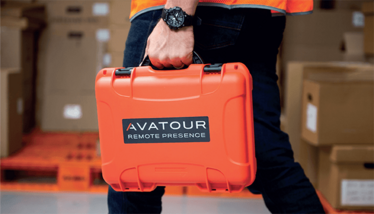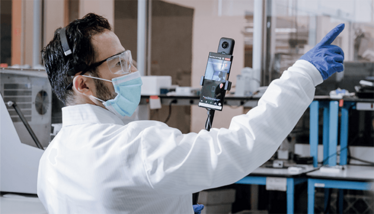The 360 Virtual Tour
How Avatour is digitally transforming audits and inspections for the pharma industry
According to a report from McKinsey & Company, the COVID-19 pandemic has accelerated the adoption of digital technologies “by several years" (1). In many cases, these technologies have transformed the way people work – and they are likely here to stay.
Just one example from my own role as editor of The Medicine Maker: My business landline phone, once an everyday tool, sits collecting dust. Now, calls are conducted via video – and it’s almost baffling to think of a time when everything was done via phone – afterall, it’s so much nicer to see the face of the person you are speaking with.
What if there was a step further than videoconferencing? A company called Avatour has developed 360° camera technology that can be used for numerous applications that go far beyond simple conferencing – think of virtual tours, on-site training, and even virtual regulatory inspections. According to the company, the technology enables “remote collaborators and on-site personnel to share the context of a real place.” You can either don a VR headset (such as Meta Quest or Pico VR headsets) or log in using a web browser – where you can explore a space by clicking and dragging to look around.
I caught up with Devon Copley, CEO and co-founder of Avatour, to learn more about where the company came from – and how it’s being used by pharma customers.

What’s the story behind Avatour and its technology?
I met my co-founder, Prasad, when we both started leading a team developing software for the world’s first integrated 360° camera, the Nokia OZO. It was an enormously exciting and challenging project… But that $60,000 VR capture device was unfortunately ahead of its time. After a couple of years the project was shut down, and we found ourselves with a nice severance package, a great working relationship, and many ideas.
We were determined to start a company together. We believed in the potential of immersive technology, but we wanted to create something that would deliver real business value now – not 5 or 10 years into the future. The main insight we had was that almost every new technology’s “killer app” involves communication. We had a hunch that real-time immersive capture could be the basis of a new category of communication technology. So we set out to build it.
Initially, we had some vague ideas of target verticals – real estate, construction, tourism – but as we started to develop prototypes, it’s fair to say we were a technology in search of a problem. In business school, I learned that’s a very dangerous way to start a business – and it’s true. We barked up an awful lot of wrong trees – and burned through our severance very fast – but through a combination of persistence and serendipity, we were able to discover the use cases where customers really needed our product, including in the pharmaceutical industry.
You had a beta release in 2019; how did the pandemic change things?
I think the impact of the pandemic for us hasn’t been so much about expanding our use cases for the technology, but more about lowering resistance to the use of remote technology in general.
In late 2019, during our beta program, we had started to identify the inspection/audit space as a really high-value use case. In particular, we found a great deal of interest from the FDA-regulated industries of pharmaceuticals, medical devices, and food production. We had some engagements with the “innovation” teams at a number of potential customers, but we kept having difficulty getting our system actually deployed in the field. There was a reluctance to try something new when existing solutions weren’t exactly broken.
The pandemic changed that situation dramatically and suddenly. When the scope of disruption became clear in March 2020, we started getting phone calls: “Can you take a credit card, ship today for Saturday delivery, and train us on Sunday?” Before the end of the month, nearly all of our beta customers converted to contracts.
This initial panic buying lasted only a few months, but it’s given way to a real step change in how people think about remote technology. We’ve all seen this play out across so many aspects of our personal and business lives during the pandemic, and I believe that Avatour has a unique role to play in this “new normal.” As our customers have taken the technology and begun using it for real-world applications, we’ve come to better understand what our product is really for.
Avatour is built to share spaces, in the way that Zoom was built to share faces. It’s a fundamentally different tool from standard videoconferencing, built for a different job. It’s made for meetings where the location is a crucial component: inspections and audits, facility tours, site training, and so on. The dramatic increase in comfort with remote technology driven by the pandemic has made potential customers much more willing to try the technology for situations that previously required physical presence.

How exactly does the technology work?
The first thing to understand is that Avatour is inherently asymmetric. That is, unlike a standard videoconference, the experience must be quite different for the on-site personnel versus the remote visitors. This is easy to grasp when you think about the use cases we’re targeting – inspections, tours, etc. We’re a substitute for a site meeting, and the context of the site is a crucial part of the meeting’s content. The on-site personnel already are in that context, but we need to capture it and share it with the off-site visitors. So the hardware, software, and experience are different depending on whether you’re on-site or remote.
For remote users, we enable different ways to experience that context. A virtual reality headset is a particularly compelling way to have that experience, but it isn’t required. In fact only about 20 percent of our users typically wear VR headsets. Most remote users join Avatour sessions using a web browser on any desktop, laptop, or mobile device. Obviously this isn’t as immersive an experience as the VR headset, but it’s certainly convenient. It’s just like joining a Zoom or a Google Meet – no download is required – except that you get the benefit of the full 360-degree context of the remote site. You can think of the web experience like a real-time Google Street View, showing the lab or facility in 360°, where you can interact directly with the people there.
The on-site users make this possible using a small 360° camera and a mobile device, generally connected to some kind of stand or mount. Avatour works with several off-the-shelf 360° cameras; the whole system is battery powered and works over any Internet connection (we recommend a minimum of 5mbps uplink). The camera captures the space, while the mobile device runs the communications, showing the remote users and enabling audio communications. Our goal is to make the system appliance-like in its simplicity – just turn it on, start a session, and you’re sharing your space with remote stakeholders.
Beyond these user-facing aspects of the system, our cloud platform is what makes the whole thing work. We have multiple ingest points all around the world, and we manage and transcode the streams between the site and remote users, enabling ultra-low latency communication with full 360° capture.

How can the technology be used by pharmaceutical companies?
Avatour is generally deployed for three types of use cases: inspections, tours, and training. Among our pharma customers, inspections have been the most common applications by a wide margin. This category includes quite a range of situations including internal quality assurance, supply chain management, third-party validations, consulting engagements, and even regulatory inspections. As an example of the latter, it was widely reported that the EMA made use of Avatour for a recent inspection of a Thermo Fisher Scientific production facility in the US.
In fact, the technology is used for remote inspections in over 20 countries around the world. The specifics of the use vary somewhat by application – sometimes it’s entirely internal, sometimes a vendor/buyer relationship, sometimes a regulatory situation. In some cases, our hardware is the only on-site “representative” for the inspector; in other cases, one or more inspectors attend live, giving colleagues access to the same inspection via Avatour.
In all cases, the main benefit of Avatour versus standard videoconferencing is the real-time 360° capture because it allows the remote attendees to see whatever they want to see, not just what the on-site personnel choose to show them. This differentiator is particularly crucial when there is no inspector representative on-site, but it’s still valuable when there is on-site representation; with Avatour, you can bring multiple subject matter experts along to provide their own independent point of view. You can imagine it as if each attendees has control of their own personal camera, while they can all still communicate with each other in real time.
There are several features that further extend utility in the inspection context. Remote users have the ability to take time-stamped “snapshots” in 2D or 360, and annotate them with notes that can be exported as a report for later follow-up. A secondary camera can be attached for close-up inspections of samples or documents; we can even support specialized cameras like digital microscopes and borescopes. And the entire session can be recorded for later collaborative review – including the full 360° capture, so that during review you can even “see” things you missed the first time!
I think the benefit is particularly apparent for the physical inspections of sites, but it can also be useful during the interview and document review portions of an inspection. We did some recent work in Pakistan with a well-known NGO; they used Avatour’s secondary camera feature to review documents, while using the 360° feature to keep an eye on who entered and left the room, monitoring their body language, and so on. After all, an inspection goes well beyond the narrow field of view of a phone camera. By giving remote attendees the full picture, Avatour might not be quite the same as being there – but it’s the next best thing.
Increasingly, we’ve seen our life sciences customers exploring other applications of Avatour. Tours are a useful sales and marketing tool for any contract production facility, and the ability to offer a tour without a physical visit can result in quicker sales cycles and better customer relationships. And we’ve also seen Avatour used for method transfer, when a process needs to be scaled up at a new production facility.
Do you think the pandemic has initiated a long-term change in how companies operate?
Absolutely – there’s been a massive change. We’ve heard it directly from our customers – they tell us in no uncertain terms that they do not expect things to go back to the way they were, especially when it comes to business travel. It’s not just about the unpredictability of the pandemic, either; we were hearing the same story pre-Delta; I think it’s because remote collaboration tools have really proven themselves. They’ve become part of our everyday lives in a way they just weren’t before. I’m sure we’re all looking forward to the days when we can travel and interact more freely again – but I don’t expect the deployment of remote tools to recede.
The term “digital transformation” is often thrown around as a buzzword in the pharma industry. What does the term mean to you? And what transformative steps can pharma companies take?
I think if you want to take the notion of “digital transformation” beyond just a buzzword, you need to get past merely digitizing existing procedures, and think about how the processes themselves can evolve. Let me give a concrete example: a number of companies have deployed Avatour to replace a portion of their existing quality assurance audits with remote inspections. And that’s a win in itself, delivering reduced travel costs and better time utilization. But the more advanced customers think past that and explore how a tool like this might change the very nature of the quality assurance process. If it’s no longer expensive for a QA inspector to visit a site, perhaps they visit every two weeks instead of twice a year? Perhaps this allows the entire interaction to shift away from a high-stakes, adversarial event towards a continuous improvement relationship? And perhaps this could not just deliver the same results at less expense – but better results? When you’re finding ways that new digital tools can unlock these kinds of deep improvements, that’s real transformation.
Any final words for The Medicine Maker community?
On a personal note, I know that readers of The Medicine Maker are people with advanced technical experience in a booming industry, with lots of career options. The big multinationals offer terrific security and benefits and all that. But if you’ve ever wondered about being part of a startup, you should really give it a shot. There’s nothing quite like being part of a small team building something new. It’s not easy, and it can be a bit of a roller coaster – but it’s never boring!
- McKinsey & Company, “How COVID-19 has pushed companies over the technology tipping point—and transformed business forever,” (2020). Available at https://mck.co/3HFo5VE

Making great scientific magazines isn’t just about delivering knowledge and high quality content; it’s also about packaging these in the right words to ensure that someone is truly inspired by a topic. My passion is ensuring that our authors’ expertise is presented as a seamless and enjoyable reading experience, whether in print, in digital or on social media. I’ve spent fourteen years writing and editing features for scientific and manufacturing publications, and in making this content engaging and accessible without sacrificing its scientific integrity. There is nothing better than a magazine with great content that feels great to read.



















